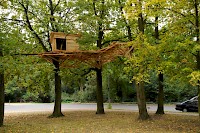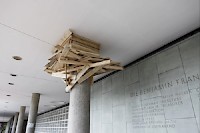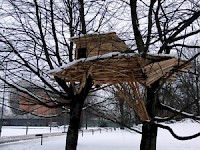Nests: Tadashi Kawamata and the Virtual
We call the determination of the virtual content of an Idea differentiation; we call the actualisation of that virtuality into species and distinguished parts differenciation.
—Deleuze, Difference and Repetition, 207
It is interesting to consider the architectural and sculptural intervention work of Tadashi Kawamata from the perspective of the virtual. Virtuality in this context does not emerge from an illusory, digitally suggested reality, but can rather be understood as a potentiality of a situation, object, state of being and which is suggested with analogue means. Deleuze’s distinction between the actualization of the virtual and the realization of the possible in Difference and Repetition is helpful in this context. For Deleuze, following Bergson, the possible is a correlative of the real: the possible is that which will be expressed and transformed into the real. The possible conforms to the real, like a plan that can be materialized. The real is therefore near to the possible, but also represents a limitation of the possible. The possible represents a past stage of the real. On the contrary, the virtual is put in relation to the actual. The virtual is real, but has no actuality in the present. The actual does not resemble in any way to the virtual, does not limit it, and does not select from it. “The difference,” he writes, “is always the actualization of a virtuality, which is independent from the existence of its actual, divergent Line.” (Deleuze 1994, 120). The actual is therefore connected to virtuality by difference and divergence – which is understood by Deleuze as a form of creation.
The urban nests of Tadashi Kawamata (b.1953) are for me an example of this divergence, which as I will show is performative in its nature. The tree Nests exhibited in the Haus der Kulturen der Welt in Berlin (2009–10) were part of a larger series of nests or inserts, which Kawamata introduces in the urban fabric, using particular rules of production and multiplication, and reaching a deviant transformation of the built environment. His structures can be regarded as anomalous manifestations of what the urban life could produce. His sculptural shelters, which cite a habitational order other than the human, create a reality, which even though it takes a concrete form (and becomes an integrated component of the urban landscape), maintains a potentiality, which belongs rather to the domain of the virtual, as Deleuze theorizes it, than to the one of the possible. Kawamata expresses a world, not of the what can be (in terms of cultural praxis), but of the what could be (as a crossing of different biomorphic human, animal, vegetal configurations) These hybrid forms, which have no functions in the urban environment, unfold an own functional system and make therefore a philosophical statement: a reality can be generated, which isn’t practically possible (and doesn't belong to the possible in the sense of Deleuze), but which can be nevertheless present and effective. This can be understood as a temporary manifestation of a potentiality: the works bring out new functions in a given system or create systems for the functioning of a certain idea. In this sense this could is also connected to a creative gesture, which operates an innovation in the given (actual) reality, with a conceptual hybrid that is surpassing what a system can actually generate and belongs rather to the domain of the virtual.
My argument is that contrary to obtaining the virtual with digital means, by reproducing and manipulating a reality, the virtual in the work of Kawamata, reached with analogue means, is based on and is transmitted through performativity. The performativity, which signifies that making an utterance is doing an action1, lies in his work in that his nests generate a reality by their mere existence, which emerges from the potentiality of the context in which they are situated and which becomes communicable and temporary actualisable. The reality of a potentiality, that is the virtuality of a situation, object, action in relation to which his works are placed, becomes through his interventions temporary actual, transmittable and effective. For this, his works do not belong to the domain of the possible (his interventions do not correspond to the functional possibilities of a certain environment and do not belong to its reality), but are nevertheless real, actualisable and effective in a performative way.
Starting from the interior of the cultural center <Haus der Kulturen der Welt> in Berlin, the nests spread out on the exterior architectural elements and reach out finally in garden of the edifice, up in the trees. They function as architectural constructions, which using improvisatory and provisory techniques, creep and hide into the corners of the institutional block. The defy the status, order and meaning of construction, its urban significance and spatial and temporal claims, by being functionless, meaningless and subjected to decay. Kawamata is questioning with his re-constructive practices the legitimacy of value, status, representational codes, transmitted through architecture – understood as a means of order, limpidity and progress.
Kawamata’s works are based on an investigation of the cultural inherent potential of the existing environment. His formations, tidily connected to the urban streets, bridges, scaffolds, reveal a point from which other environments begin, instituting another order of the real. Interfering with the culturally inherited structural logic of build and signified environment and especially with its hierarchic and repressive system of expression, Kawamata superposes other invasive and labyrintic principles of constructions, as he superposes his polymorphous elements on pre-existing structures, based on motion, chance, transformation, chaos. His works are, in the sense of Deleuze, not possibilities offered by the space and its concrete constructed reality. They do not build another possible reality, and do not tell what reality can become, if it follows its inherent, historically exercised principles of being. On the contrary they show us what it could be, if these principles would be detoured and another system of signification would appear. In this sense they belong to the domain of the virtual, by expressing an otherwise unmaterialisable potentiality, which is temporary actualised in his works.
The creative attempt of Kawamata’s works can be regarded as being the difference, which he introduces into the order of reality, from which the virtual dimension of his works stems. As with the Berlin Nests, his organic works, even though lacking functionality, end up seeming more real, more natural and meaningful, than the initial construction, strongly planted in the existing urban reality, like the Haus der Kulturen der Welt with its institutional authority. His work is improvisational, and starts to have a life of its own, not in account of a pre-existing meaning, but due to its performativity: the work does what it states, just by being there. The presence of the Nests operates a displacement: the space is relocated, re-placed and expresses the reality of another virtual configuration. Due to the improvisational character of his works, their incompleteness, and their incapacity of having finality, they express a virtual, which has temporary actualisations. His works remain in a state of suspension – performatively.
The difference between the two terms differentiation and differenciation which Deleuze uses in the fragment cited at the beginning of this article, is a fundamental one regarding the theory of the virtual. As Adrian Parr (Parr, 2005, 75-76) explains, differentiation, originally a mathematical concept is for Deleuze an open system in which new connections and directions are continually produced. What are differentiated are intensieties and heterogeneous qualities. Differentiation happens only in the realm of the virtual. Differentiation is a process of continuous dividing and combining and it represents a creative flow. This flow is also what makes the virtual real, although not actual. Differenciaciation, on the contrary, represents the moment of the actualisation of the virtual. This actualisation can be either material or conceptual.
In Deleuze’s interpretation, virtuality belongs to a past, which didn’t exhaust in the process of its transformation and belongs to a future, which cannot be anticipated. The difference about which Deleuze speaks, is a net of relations, which appears through unpredictable configurations and in which the present is not predetermined by the past. As long as it exists as such, virtuality has a reality which has the power to be productive. Its effect is generating difference and divergence from the lived actuality. Kawamata operates, with the principle of virtuality, in the sense in which his works offer the potentiality of different and differentiated forms of presence.
Deleuze also writes: “We can see that the differentiating is never a negative, but always a creative act, and that the difference is never negative, but always positive and creative.“ (Deleuze 2007, 128)
1 (see pg. ? in this volume)
Bibliography: Deleuze , Gilles (2007): Henri Bergson, zur Einführung, Junius Verlag, Dresden
Deleuze , Gilles (1994): Difference and Repetition, Coumbia Universityy Press, New York
Jensen, Marianne Krogh : „Mapping Virtual Materiality“ in Weibel, Peter (Ed.) [2001]: Olafur Eliasson: Surroundings Surrounded, The Mit Press, Cambridge, Massachusetts, 302-312
Grosz, Elisabeth: „The Future of Space: Toward an Architecture of Invention“ in Weibel, Peter (Ed.) [2001]: Olafur Eliasson: Surroundings Surrounded, The Mit Press, Cambridge, Massachusetts, 252-268
Parr, Adrian, “Differentiaion / Differenciation” in The Deleuze Dictionary, Ed .Parr,Adrian, Edinburg University Press, 2005, 75-76
Austin, J.L. (1975), How to do things with words,, Harvard University Press,, Harvard



